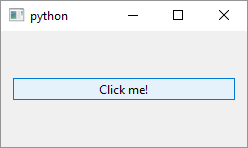Signals and Slots Example with Lambdas

1
2
3
4
5
6
7
8
9
10
11
12
13
14
15
16
17
18
19
20
21
22
23
24
25
26
27
28
29
30
31
32
33
34
35
36
37
38
39
40
41
42
43
44
45
46
47
48
49
50
51
# If the signature of a signal matches
# the signature of the receiving slot
# you can use the signal's arguments in the slot.
# If a slot has a shorter signature
# than the signal it is connected with
# the extra arguments are ignored
# Demonstrate using a Python lambda function
# as a slot. Lambdas are anonymous functions,
# ie. they have no name.
import sys
from PySide6.QtWidgets import (QApplication,
QWidget, QPushButton, QVBoxLayout)
class Window(QWidget):
def __init__(self):
super().__init__()
layout = QVBoxLayout()
self.setLayout(layout)
# 1 - Create the widget, same as in the basic example
button = QPushButton('Click me!')
button.setCheckable(True)
# 2 - In this case the slots are Python lambdas
# placed in the button.clicked.connect() call.
# We have two slots connected to the same signal.
button.clicked.connect(lambda: print('Clicked...'))
button.clicked.connect(lambda checked: print(checked, 'Something else'))
layout.addWidget(button)
if __name__ == '__main__':
app = QApplication(sys.argv)
main_window = Window()
main_window.show()
sys.exit(app.exec())
The pattern is the same as in the basic signals-slots example:
-
Create the widget. It’s the same
QPushButtonas in the first script only now we set itscheckable()property toTrueso it can double as a toggle button. Without this itscheckedproperty doesn’t toggle on mouse click. -
Connect the
QPushButton.clicked()signals with slots. There are three things to note here:-
You can connect a Python lambda function (ie. a function without a name) instead of an ordinary method/function to a signal,
-
There are two slots (in this case lambdas) connected to the same signal and each will be called when the signal is emitted. You can also connect multiple signals with a single slot.
-
You can use a lambda to pass parameters to a slot. In the script,
checkedthat matches the signal signature, but'Something else'is additional data passed to the actual function that will handle the signal.
-
(Can you add a @Slot() annotation to a lambda?)